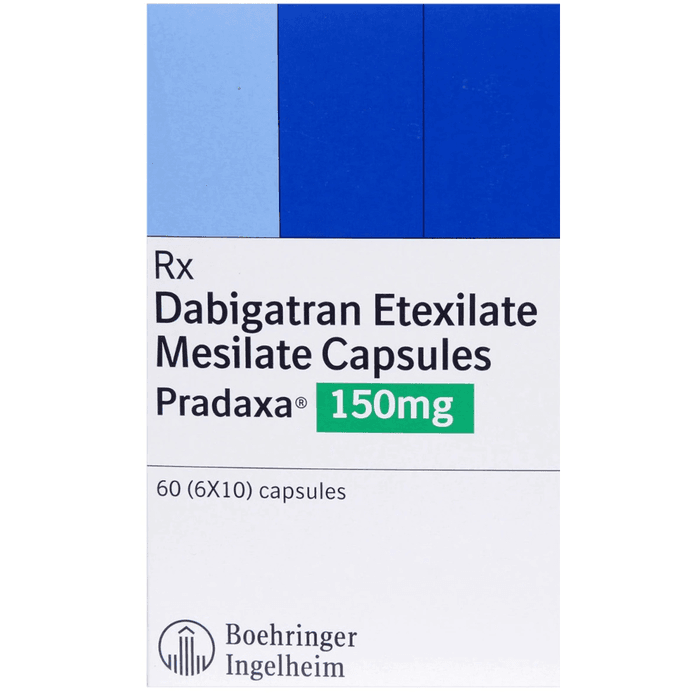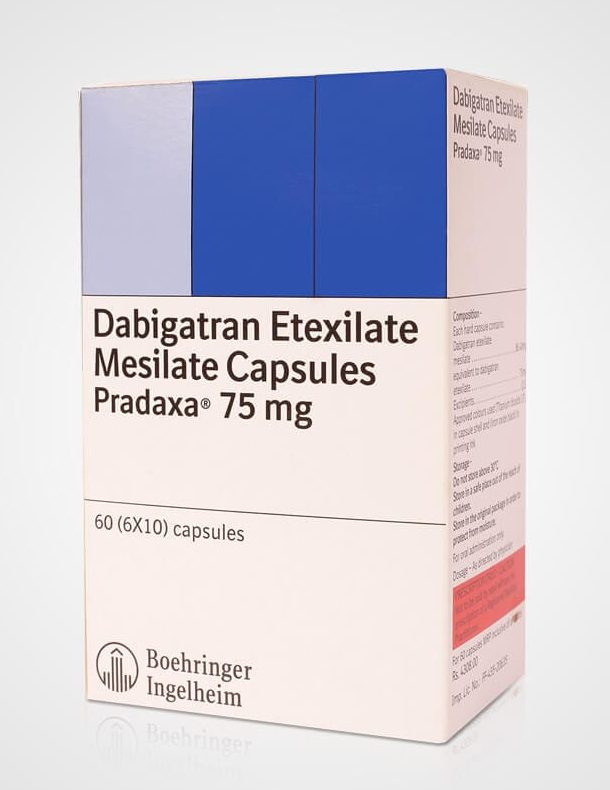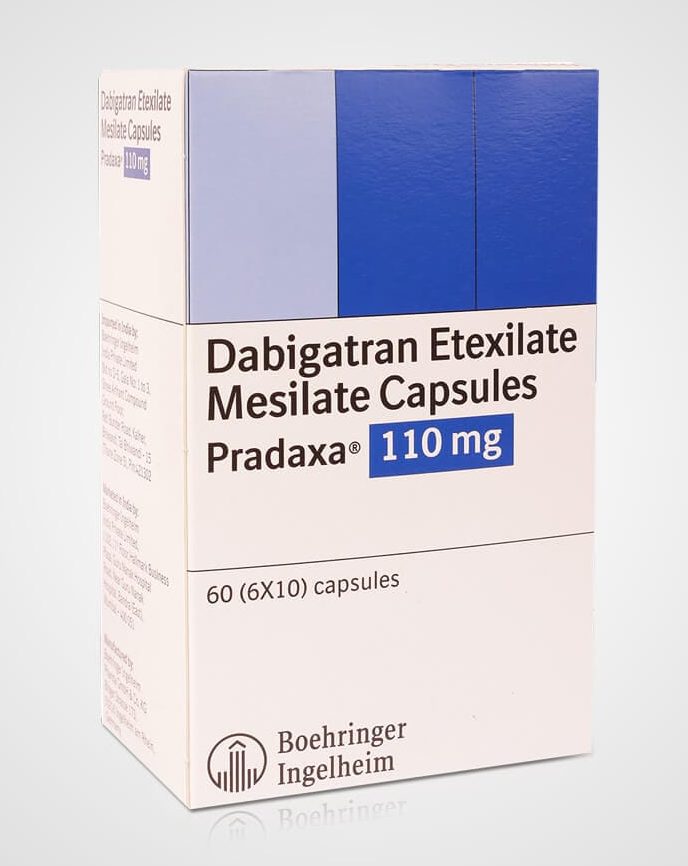Please note: a valid prescription is required for all prescription medication.
Pradaxa® is a dabigatran etexilate capsule used to prevent and treat harmful blood clots. This page explains how it works, who it suits, and how to access Canadian pricing that ships to the US. You can review costs even without insurance.
What Pradaxa® Is and How It Works
Pradaxa is an oral anticoagulant in the direct thrombin inhibitor class. After you swallow the capsule, dabigatran etexilate converts to dabigatran, which blocks thrombin (factor IIa). Thrombin turns fibrinogen into fibrin, a key step in clot formation. By inhibiting thrombin, Pradaxa lowers the chance of clots forming or growing. It is used to reduce stroke risk in certain heart rhythm conditions and to treat or prevent venous clots. At CanadianInsulin, orders are filled by licensed Canadian pharmacies after we confirm a valid prescription with your clinic. Medicines are dispensed in Canada for US delivery.
Pradaxa does not thin blood in the literal sense. It changes clotting activity so your blood is less likely to form dangerous clots. Its effect begins soon after dosing and wears off as the medicine is cleared by your kidneys.
Who Pradaxa® Is For
Pradaxa is indicated for adults with non-valvular Atrial Fibrillation to reduce the risk of stroke and systemic embolism. It is also used for the treatment of Deep Vein Thrombosis and pulmonary embolism, and to reduce the risk of recurrence after initial therapy. In adults who have had hip replacement surgery, it helps prevent DVT and PE.
People with active pathological bleeding should not take Pradaxa. It is not recommended for patients with mechanical prosthetic heart valves. Tell your clinician about kidney problems, liver disease, a history of bleeding, stomach ulcers, or recent procedures, because these factors affect safety and dosing decisions.
Dosage and Usage
Follow your clinician’s directions and the official label. Typical adult regimens include:
- Non-valvular atrial fibrillation: 150 mg by mouth twice daily for many adults.
- Treatment of DVT/PE: after 5 to 10 days of a parenteral anticoagulant, 150 mg twice daily.
- Reduction in the risk of recurrent DVT/PE: 150 mg twice daily.
- Prevention of DVT/PE after hip replacement: an initial dose may be given, then a once-daily maintenance dose as instructed on the label.
Swallow capsules whole with a glass of water. Do not open, crush, or chew them. Take doses at the same times each day. If your clinician has advised dose changes for kidney function or drug interactions, follow those instructions exactly.
Strengths and Forms
Pradaxa capsules are commonly available in these strengths:
- 75 mg capsules
- 110 mg capsules
- 150 mg capsules
Availability may vary by supplier and prescription.
Missed Dose and Timing
If you miss a dose, take it as soon as you remember on the same day. If it is almost time for your next dose, skip the missed dose and take the next dose at the regular time. Do not take two doses at once. For once-daily regimens, take the missed dose the same day; otherwise, resume the next day at your usual time.
Storage and Travel Basics
Store Pradaxa at room temperature in the original bottle with the desiccant cap or in blister packaging until use. Keep the bottle tightly closed to protect from moisture. Use the capsules within 4 months of opening the bottle. Do not store in pill organizers for extended periods, as moisture can reduce potency.
When traveling, keep your medication in your carry-on, in the original labeled container. Avoid extreme heat or cold. Bring a copy of your prescription and your prescriber’s contact details.
Benefits
Pradaxa provides established protection against stroke in non-valvular atrial fibrillation and treats or prevents DVT and PE as labeled. It is taken by mouth and has a predictable anticoagulant effect in many patients. Routine blood test monitoring to measure drug effect is not typically required, which simplifies day-to-day use. Fixed dosing schedules support consistent therapy when taken as directed.
Side Effects and Safety
- Bleeding or bruising more easily than usual
- Nosebleeds or bleeding gums
- Indigestion, stomach discomfort, or heartburn
- Upset stomach or nausea
Serious risks include major bleeding, which may present as blood in urine or stool, coughing up blood, severe headache, sudden weakness, or unusual pain or swelling. Spinal or epidural hematomas can occur in patients receiving neuraxial anesthesia or spinal procedures, which may cause long-term or permanent paralysis. Stopping anticoagulation suddenly can increase the risk of a clot or stroke. In emergencies, a specific reversal agent for dabigatran may be used at the hospital. Seek urgent care for signs of serious bleeding or stroke symptoms.
Drug Interactions and Cautions
Tell your clinician and pharmacist about all medicines and supplements you take. Pradaxa interacts with drugs that affect P-glycoprotein (P-gp). Strong P-gp inhibitors, such as ketoconazole or dronedarone, may raise dabigatran levels. P-gp inducers, such as rifampin, may lower effectiveness. Combining Pradaxa with other anticoagulants or antiplatelets increases bleeding risk. This includes agents like Warfarin, enoxaparin, aspirin, and clopidogrel. Non-steroidal anti-inflammatory drugs may also increase bleeding risk.
Use caution if you have kidney impairment, liver disease, a history of stomach ulcers, recent surgery, or are older. Discuss pregnancy and breastfeeding considerations with your clinician. Always inform healthcare providers that you take an anticoagulant before any procedure or new prescription.
For background reading on class comparisons, see our editorial on Warfarin Anticoagulant.
What to Expect Over Time
Anticoagulant effects begin soon after starting therapy. Many people continue therapy long term for stroke prevention in atrial fibrillation or for extended DVT/PE protection when appropriate. Your prescriber may schedule periodic check-ins to review kidney function, bleeding risk, and ongoing need for treatment. Report any unusual bleeding or signs of clotting promptly.
Compare With Alternatives
Other approved oral anticoagulants include Eliquis® (apixaban) and Xarelto® (rivaroxaban). All are effective options when used as directed, but they differ in dosing, renal considerations, and labeled uses. Your clinician will help choose based on your medical history and medicines. For more on how another DOAC is used, see our overview Eliquis Uses.
Pricing and Access
With Canadian pricing and US delivery from Canada, you can review the Pradaxa price and compare options by strength and quantity. Many patients look at the Pradaxa 150 mg price, the Price of Pradaxa 150 mg, and the Pradaxa 75 mg price when planning therapy. You can also compare the Pradaxa cost, Pradaxa cash price, Pradaxa retail price, and estimated out of pocket cost. If you need to understand how dose size affects totals, you can review Dabigatran 150 mg price alongside other strengths on the product page. For cross-border orders, listings show Pradaxa price from Canada with US shipping.
To see current pricing, select your strength and quantity. Use our secure checkout to complete your order. Checkout is encrypted. For additional seasonal offers, visit our Promotions page. Choose the option that fits your prescriber’s directions and refill plan.
Availability and Substitutions
If a specific strength is unavailable, your prescriber may recommend a suitable alternative medicine or a different strength when clinically appropriate. Do not change your dose or switch anticoagulants without clinical guidance.
Patient Suitability and Cost Saving Tips
Pradaxa may be considered for adults who need prevention of stroke in non-valvular atrial fibrillation or treatment and prevention of DVT/PE per the label. It is not for patients with mechanical valves, active bleeding, or certain drug interactions. Kidney function and bleeding risk are important in deciding whether this medicine is right for you.
To help manage costs, consider:
- Comparing Canadian pricing across strengths before you order.
- Selecting multi-month quantities if your prescription and budget allow.
- Setting refill reminders so you do not miss doses.
- Reviewing benefits and pharmacy receipts for any eligible reimbursement.
Questions to Ask Your Clinician
- Is Pradaxa the right anticoagulant for my condition and kidney function?
- How long should I stay on therapy for stroke prevention or DVT/PE?
- What bleeding signs should I watch for, and when should I seek care?
- Do any of my medicines or supplements interact with dabigatran?
- What should I do before surgery, dental work, or a spinal procedure?
- How should we monitor my kidney function and ongoing need for therapy?
Authoritative Sources
- FDA DailyMed: Pradaxa Label
- Boehringer Ingelheim: Pradaxa Information
- Health Canada Drug Product Database
When you are ready, place your order for prompt, express US delivery from Canada.
Express Shipping - from $25.00
Shipping with this method takes 3-5 days
Prices:
- Dry-Packed Products $25.00
- Cold-Packed Products $35.00
Standard Shipping - $15.00
Shipping with this method takes 5-10 days
Prices:
- Dry-Packed Products $15.00
- Not available for Cold-Packed products
How does Pradaxa work?
Pradaxa blocks thrombin, a key clotting enzyme also known as factor IIa. By inhibiting thrombin, it lowers the chance that clots will form or grow.
What are common Pradaxa doses?
Common adult regimens include 150 mg twice daily for non-valvular atrial fibrillation and for DVT/PE treatment or prevention. Hip replacement prophylaxis uses a label-directed once-daily schedule.
Can I open Pradaxa capsules?
No. Swallow the capsules whole with water. Do not open, crush, or chew, because that can increase absorption and bleeding risk.
Do I need routine blood tests on Pradaxa?
Routine tests to measure drug effect are not typically required. Your clinician may check kidney function and other labs regularly to ensure safe use.
What should I do if I miss a dose?
Take the missed dose as soon as you remember on the same day. If it is close to the next scheduled dose, skip the missed dose. Do not double up.
Is Pradaxa safe before surgery or spinal procedures?
Tell your clinician you take an anticoagulant. You may need to stop Pradaxa before certain procedures to reduce bleeding risk. Follow your clinician’s instructions.
What are the serious risks of Pradaxa?
Major bleeding is the main risk. Spinal or epidural hematomas can occur with neuraxial anesthesia. Seek urgent care for signs of serious bleeding or stroke.
Rewards Program
Earn points on birthdays, product orders, reviews, friend referrals, and more! Enjoy your medication at unparalleled discounts while reaping rewards for every step you take with us.
You can read more about rewards here.
POINT VALUE
How to earn points
- 1Create an account and start earning.
- 2Earn points every time you shop or perform certain actions.
- 3Redeem points for exclusive discounts.
You Might Also Like
Related Articles
Atopica Cats Medication: Relief for Itchy, Allergic Skin
When your cat constantly scratches, bites, or licks their skin, it’s not just uncomfortable for them; it can be heartbreaking to watch. Allergies in cats are more common than many…
National Diabetes Education Week: Tools for Better Care
Every November, millions of people come together to raise awareness about diabetes, a condition that affects more than 38 million Americans. Among the month-long initiatives, National Diabetes Education Week stands…
Diabetic Eye Disease Month: Protect Your Vision Today
Vision is one of our most precious senses, yet millions of people with diabetes are at risk of losing it without even realizing it. According to the Centers for Disease…
Join the Cause: American Diabetes Month 2025
Every November, millions of Americans come together to shine a light on one of the country’s most pressing health challenges — diabetes. American Diabetes Month is more than just a…





